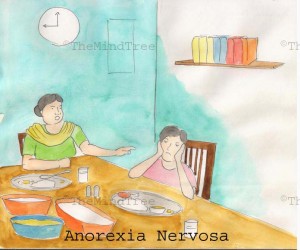FACTS ABOUT FEEDING AND EATING DISORDER
Feeding and Eating Disorder is a disorder in which children suffer from abnormal eating habits.

In Bulimia Nervosa a child eats excessively, overeating all the time to the point of self vomiting. There are episodes of intense over-eating, when a person consumes a very large quantity of food in a very short span of time, it can be a potentially life threatening disease.
As a result medical problems like expansion of stomach, obesity develops in a child.
SYMPTOMS
- Abnormal bowel functioning
- Sores in the throat and mouth
- Damage to teeth and gums
- Heartburns
Case Studies
P, 18 weighs 84 kg which is 18 kg’s overweight according to his BMI (body mass index). His diet is good states his mother, but atleast twice a week he indulges in intense episodes of overeating. She describes one such instance; when after having lunch with P, she went to the market by the time she returned the fridge was empty; he ate 2 kg’s of icecream, remaining of the lunch, 10 packets of biscuit, one full loaf of bread with a packet of cheese slices and frozen potato nuggets. All this P ate in half an hour. She says she was shocked to see her son in such a state after which he vomited and later had severe diarrhoea. P feeling embarrassed says he doesn’t remember what he eats, during such episodes of eating. It’s a feeling that no matter what I eat or how much I eat my stomach is never going to be full. He often suffers from stomach problems and is concerned about his health. He was diagnosed with bulimia nervosa.

In Anorexia nervosa the child eats severely less than the required minimal intake required for the human body. It is basically starving the body for food.
Children with this disorder have risk of having malnutrition and become severely underweight.
SYMPTOMS
- Refusal to eat
- Denial of hunger
- Fatigue
- Brittle nails
- Underweight
- Almost forced to eat
Case Studies
V, age 16 is severely underweight and it’s hard not to notice it. Her mother who brought her to the clinic is very upset and worried about her daughter’s eating habits, where she hardly eats anything by herself, she is to be forced to drink milk and making her eat daily meals have become a tedious task. She sometimes sneaks the food from plate and hides it in her room or throws away in the dustbin and pretends she has eaten it. Eating green vegetables, pulses and grains are a strict no for V, she often fights with her mother and cries when forced to eat these things. As a result of this behaviour, she has developed serious deficiencies of calcium, iron and vitamins. V says she doesn’t feel hungry and is not fond of food. She shyly admits that she doesn’t want to become obese and is happy with the way she looks, not realising how her habit is dangerously affecting her health in what is the developing stage of her mind and body. She is diagnosed with anorexia nervosa and her medications were immediately started to deal with the deficiencies her body had developed, her condition is alarming as these symptoms have persisted for over 10 months.
It can be termed as eating an amount of food that is definitely larger than what most people would eat in a similar period of time under similar circumstances, or a sense of lack of control over eating during that episode (example, a feeling that one cannot stop eating or control what or how much one is eating).
Symptoms
- At-least 3 or more of the following symptoms should occur:
- Eating much more rapidly than normal
- Eating until feeling uncomfortably full
- Eating large amounts of food when not feeling physically hungry
- Eating alone because of feeling embarrassed by how much one is eating
- Feeling disgusted, depressed and very guilty afterwards
- Binge eating occurring at-least once a week for a minimum period of 3 months
It can be defined as a repeated regurgitation of food, which includes re-chewing, re-swallowing and spitting out of food.
This habit should be continuous in a child for a minimum period of 1 month to be categorized under this disorder.
It can be defined as an eating or feeding disturbance, where there is apparent lack of interest in eating of food, this avoidance is primarily based on the sensory characteristics of food. For example: a child is concerned that if he/she eats that food, it will have some aversive consequences. The consequences of such behaviour may be nutritional deficiencies, which has negative effects on the natural development of the body
SYMPTOMS
- Significant weight loss
- Faltering growth of body
- Nutritional deficiency
- Marked interference with psychosocial functioning
- Dependence on oral nutritional supplements

